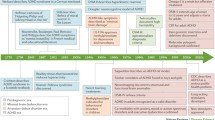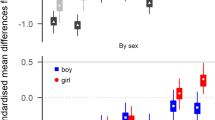Abstract
Attention-Deficit/Hyperactivity Disorder (ADHD) is reported to have an incidence of 3–5%, and is associated with a variety of interpersonal, academic, and social problem behaviors. There is controversy as to whether ADHD is a learned behavioral or brain dysfunction. Research has explored a variety of measures to assess behavioral and brain dysfunctions in this population, with no consistent and clearly diagnostic results. We investigated whether a new psychometric and a new electroencephalographic procedure would clearly differentiate ADHD. The psychometric was based on DSM-IV criteria and the EEG measure was based on the assumption that ADHD interferes with cognitive transition from one discrete task to another. Parents of four ADHD boys (ages 8–12) and four age- and interest-matched non-ADHD boys completed the ADHD Symptom Inventory, while their sons' EEG was monitored during viewing of a video and reading of a book. For the ADHD boys, this was repeated a second time, 3 months later, to assess test-retest reliability. Both the psychometric and the EEG measures clearly differentiated the two samples (p's < .01) with no overlap in scores, were reliable over 3 months (r = .87), and were significantly correlated with one another (r = .85). While a small sample size, these robust, related and reliable findings suggest that both the psychometric and the psychophysiological EEG measures deserve further replication and exploration.
Similar content being viewed by others
REFERENCES
Achenbach, T. M., & Edelbrock, C. (1983). Manual for the Child Behavior Checklist. Burlington, VT: University of Vermont Department of Psychiatry.
American Psychiatric Association (1994). Diagnostic and Statistical Manual of Mental Disorders (4th ed.). Washington, DC: Author.
Barkley, R. A. (1990). Attention Deficit Hyperactivity Disorder. New York: Guilford Press.
Barkley, R. A., Fischer, M., Edelbrock, C. S., & Smallish, L. (1990). The adolescent outcome of hyperactive children diagnosed by research criteria: An 8-year prospective follow-up. Journal of the American Academy of Child and Adolescent Psychiatry, 29, 546–557.
Bawden, D. (1993). Predicting Ritalin response with neurometric testing: Case studies. In L. F. Koziol, C. E. Stout, and D. H. Ruben (Eds.), Handbook of childhood impulse disorders and ADHD: Theory and practice (pp. 60–77). Springfield, IL: Charles C. Thomas.
Biederman, J., Newcorn, J., & Sprich, S. (1991). Comorbidity of attention deficit hyperactivity disorder with conduct, depressive, anxiety, and other disorders. American Journal of Psychiatry, 148, 564–577.
Box, G. E. P., & Jenkins, G. M. (1976). Time Series Analysis: Forecasting and Control (rev. ed.). San Francisco: Holden-Day.
Crawford, H. J., & Barabasz, M. (1996). Quantitative EEG magnitudes in children with and without attention deficit disorder during neurological screening and cognitive tasks. Child Study Journal, 26, 71–86.
Garcia-Sanchez, C., Estevez-Gonzalez, A., Suarez-Romero, E., & Junque, C. (1997). Right hemisphere dysfunction in subjects with attention-deficit disorder with and without hyperactivity. Journal of Child Neurology, 12, 107–115.
Goldstein, S., & Ingersoll, B. (1993). Controversial treatments for children with ADHD and impulse disorders. In L. F. Koziol, C. E. Stout, D. H. Ruben (Eds.), Handbook of Childhood Impulse Disorders and ADHD: Theory and Practice (pp. 144–160). Springfield, IL: Charles C. Thomas.
Goyette, C. H., Conners, C. K., & Ulrich, R. F. (1978). Normative data on Revised Connors Parent and Teacher Rating Scales. Journal of Abnormal Child Psychology, 6, 221–236.
Heilman, K. M., Voeller, K. K. S., & Nadeu, S. E. (1991). A possible pathophysiological substrate of attention deficit disorder hyperactivity disorder. Journal of Child Neurology, 6(supp), S74–S79.
Hill, R. (1998). The EEG Consistency Index as a measure of Attention Deficit Disorder among children. Dissertation, University of Virginia.
Hynd, G. W., Semrud-Clikeman, M., Lorys, A., Novey, E., & Eliopolus, D. (1990). Brain morphology in developmental dyslexia and attention-deficit disorder/hyperactivity. Archives of Neurology, 47, 919–926.
Hynd, G. W., Semrud-Clikeman, M., Lorys, A., Novey, E., Eliopolus, D., & Lyytinen, H. (1991). Corpus callosum morphology in attention-deficit/hyperactivity disorder (ADHD): Morphometic analysis of MRI. In S. Shaywitz and B. Shaywitz (Eds.), Attention Deficit Disorder Comes of Age: Toward the Twenty-First Century. (pp. 245–260). Austin, TX: Pro-Ed.
Jasper, H. H., Solomon, P., & Bradley, C. (1938). Electroencephalographic analysis of behavior problems in children. American Journal of Psychiatry, 95, 641–658.
Klein, R., & Mannuzza, S. (1991). Long-term outcome of hyperactive children: A review. Journal of the American Academy of Child and Adolescent Psychiatry, 30, 383–387.
Kohn, A. (1989). Suffer the restless children. Atlantic Monthly, pp. 90–100.
Kuperman, S., Johnson, B., Arndt, S., Lindgren, S., & Wolraich, M. (1996). Quantitative EEG differences in a nonclinical sample of children with ADHD and undifferentiated ADHD. Journal of the American Academy of Child and Adolescent Psychiatry, 35, 1009–1017.
Lou, H., Henriksen, L., & Bruhn, P. (1984). Focal cerebral hypo-perfusion in children with dysphasia and/or attention deficit disorder. Archives of Neurology, 41, 825–829.
Lubar, J. F. (1991). Discourse on the development of EEG diagnostics and biofeedback for attention-deficit/hyperactivity disorders. Biofeedback and Self-Regulation, 16, 201–225.
Lubar, J. F., & Shouse, M. N. (1976). EEG and behavioral changes in a hyperkinetic child concurrent with training of the sensorimotor rhythm (SMR): A preliminary report. Biofeedback and Self-Regulation, 3, 293–306.
Mannuzza, S., Klein, R. G., Bonagura, N., Malloy, P., Giampino, T. L., Addalli, K. A. (1991). Hyperactive boys almost grown up: Replication of psychiatric status. Archives of General Psychiatry, 48, 77–83.
McGinnis, J. (1997, September). Attention deficit disaster. Wall Street Journal.
Merkel, L., Cox, D. J., Kovatchev, B., Morris, J., Hill, R., & Reeve, R. (1999). Double blind, placebo control, comparison of ADHD and nonADHD young adults on the EEG Consistency Index. Unpublished manuscript.
Pelham, W. E. (1982). Childhood hyperactivity: Diagnosis, etiology, nature, and treatment. In R. J. Gatchel, A. Baum, & J. E. Singer (Eds.), Clinical Psychology and Behavioral Medicine: Overlapping Principles, (pp. 261–327). Hillsdale, NJ: Erlbaum.
Pope, A. T., & Bogart, E. H. (1993). Identification of Hazardous Awareness States in Monitoring Environments. SAE Technical Paper No. 921136, SAE 1992 Transactions: Journal of Aerospace, Section 1, 101, 449–457.
Pope, A. T., Bogart, E. H., & Bartolome, D. S. Biocybernetic System Validates Index of Operator Engagement in Automated Task. Biological Psychology, 40, 187–195, 1995.
Popper, C. W. (1988). Disorders usually first evident in infancy, childhood, or adolescence. In J. A. Talbot, R. E. Hales, & Yudofsky, S. C. (Eds.), Textbook of Psychiatry (pp. 649–735). Washington, DC: American Psychiatric Press.
Risser, M. G., & Bowers, T. G. (1993). Cognitive and neuropsychological characteristics of attention-deficit/hyperactivity children receiving stimulant medications. Perceptual and Motor Skills, 77, 1023–1031.
Schachar, R., Tannock, R., & Logan G. (1993). Inhibitory control, impulsiveness, and Attention-Deficit Hyperactivity Disorder. Clinical Psychology Review, 13, 721–739.
Schachar, R., Tannock, R., Marriott M., & Logan, G. (1993). Deficient inhibitory control in Attention-Deficit Hyperactivity Disorder. Journal of Abnormal Child Psychology, 23, 411–437.
Schrag, P., & Divoky, D. (1975). The Myth of the Hyperactive Child. New York: Pantheon.
Tannock, R., Schachar, R., & Logan, G. (1995). Methylphenidate and cognitive flexibility: Dissociated dose effects in hyperactive children. Journal of Abnormal Child Psychology, 23, 235–266.
Teeter, P. A., & Semrud-Clikeman, M. (1995). Integrating neurobiological, psychosocial, and behavioral paradigms: A transactional model for the study of ADHD. Archives of Clinical Neuropsychology, 10, 433–461.
Zametikin, A., & Rapoport, J. (1987). Neurobiology of attention-deficit/hyperactivity disorder with hyperactivity. Journal of the American Academy of Child and Adolescent Psychiatry, 26, 676–686.
Author information
Authors and Affiliations
Rights and permissions
About this article
Cite this article
Cox, D.J., Kovatchev, B.P., Morris, J.B. et al. Electroencephalographic and Psychometric Differences Between Boys with and Without Attention-Deficit/Hyperactivity Disorder (ADHD): A Pilot Study. Appl Psychophysiol Biofeedback 23, 179–188 (1998). https://doi.org/10.1023/A:1022247405278
Issue Date:
DOI: https://doi.org/10.1023/A:1022247405278




